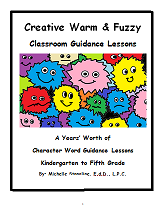Sandtray Therapy Class: History of Sandtray Therapy, Student #1
History of Sandtray Therapy: Miniature Worlds
Theoretical Beginnings
Sandtray Therapy began concurrently with the development of Play Therapy and was embedded in some of beginning theories of counseling as a way to gain insight into the child’s world through play. Margaret Lowenfeld is credited with the “therapeutic use of the sandtray and miniatures,” while Anna Freud and Melanie Klein wrote about their work with play therapy in the framework of psychoanalytic theory (Homier & Sweeney, 2011, p. 7). Play therapy and sandtray therapy were developed to help the child express their emotions and communicate their thoughts through the language of play in a world visible to the therapist.
Lowenfeld established her practice of creating “world pictures” with children based on the book Floor Games (1911) by H. G. Wells. She named her technique the World Technique in 1929. Her goal was to allow children to express themselves in creations that could be recorded and studied. She claimed this was a way of keeping a record of the child’s states apart from any interpretation or method of transference. She believed the world pictures spoke for themselves and were separate from other theories.
While Anna Freud emphasized play as a way to establish a client relationship, Melanie Klein utilized play therapy as a means of substitution for free association in psychoanalysis. This format of communication for young children was extended by Dora Kalff who adapted Sandtray Therapy to a Jungian perspective and named it Sandplay Therapy. With this, the sandtray technique became a symbolic tool for therapeutic use in play therapy.
Adaptations and Extensions
Several clinicians adapted the sandtray for assessment and diagnosis of children, using miniatures in and out of the sand. Goesta Harding developed The Erica Method for diagnosis and therapeutic use in Sweden. Charlotte Buhler standardized the World Technique to use as a diagnostic test, naming it the World Test. Another clinical assessment technique was a modification by French clinicians, de Beaumont and Arthus. Bolgar and Fischer, both clinicians from Austria, developed the Little World Test in the 1930’s to use schemas to distinguish normal and clinical profiles. Additionally, L.N.J. Kamp designed scores to represent developmental norms using the World Technique in Kansas public schools. This was further utilized in Holland to detect early learning difficulties. (Turner, 2013)
Similar to the assessments being done utilizing variations of the World Technique, Erik Erikson developed the Dramatic Productions Test (DPT). He used miniatures to understand human behavior and believed the representations were of childhood trauma. Dora Marie Klaff transformed Lowenfeld’s work as a symbolic tool in her work of Jungian psychology with children. Though Lowenfeld focused on the sandtray as a tool for communication and expression of thoughts and emotions, “Kalff saw the immediacy of the re-ordering of the psyche occurring in the creation of the sandplay itself” (Turner, 2013). Both Sandtray and Sandplay therapies are used in the assessment, diagnosis, and treatment of children and adults within a variety of theoretical orientations.
Current Applications
Sandtray and sandplay therapies are currently used with a variety of clients, including children, adolescents, and adults. It can be used “for the treatment of psychiatric disorders, developmental deprivation, trauma and personal growth” (Turner, 2013). Snadtray work can be done through a diverse range of theoretical practice, including Jungian, psychoanalytic, narrative, humanistic, and more.
Sandtray therapy is seen as one form of play therapy. It is primarily nonverbal and nonintrusive. It provides a way for clients to “work through emotional and spiritual issues, and to grow through developmental roadblocks by naturally engaging their inner lives” (Weinberg & Yockey, 2013). Because sandtray therapy involves the whole person and “solutions arise organically out of the individual,” it is therapeutic.
References
Homier, L. E. & Sweeney, D. S. (2011). Sandtray therapy: A practical manual. (2nd ed.). Routledge.
Turner, B. A. (2013). The history and development of sandplay therapy. Sandplay Therapists of America. Retrieved from http://www.sandplay.org/history.htm
Weinberg, R. & Yockey, S. (2013). What is sandplay therapy? Colorado Sandplay Therapy Association. Retrieved from http://sandplaytherapy.org/?page_id=77
Click here to read or post comments
Disclaimer: This website and its content is intended for trained licensed mental health professionals and school certified mental health professionals to use for their clients / students at their own discretion.
*If you ignore the disclaimer above are using these techniques on yourself and you feel any discomfort or upset it is highly suggested that you seek out a licensed mental health professional immediately.
"Beyond Art Therapy" is the concept from Dr. Stangline that combines all creative fields in therapy. It is not the traditional "art therapy" but goes beyond to include sand tray therapy, play therapy, mindfulness, meditation, color therapy, cognitive behavioral therapy, and a vast majority of other therapies.
For any other type of mental health emergency call your local 911 / Police Number immediately.
Dr. Stangline does not offer advice / suggestions to anyone who is not a professional mental health provider, or a student who is studying this field and has questions about mental health programs of study.
See our Exciting Selection of eBooks:
Award Winning:
Creative Counseling 101 eBook
Our Best Seller!
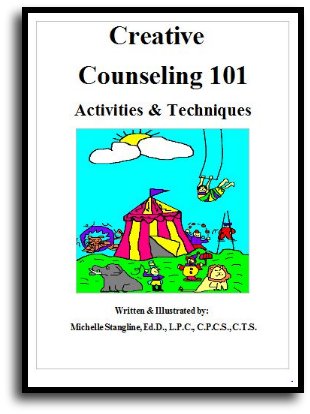
Step By Step Therapy:
Learn how to be a more Creative Therapist with the Book that started it all!
- Graduate School Counseling book used by hundreds of graduate counseling students!
- Includes full color reproducible worksheets with most activities.
- Winner of the Counselor Writer of the Year Award, 2011, Georgia Regional Award
Download Your Copy Today Only $39.95:
See Creative Counseling 101 eBook Information Here:
Get the Set
of all four
eBooks for only $98.95:
An incredible collection of how to do therapy eBooks!
A $159.80 Value,
You Save Over $60!
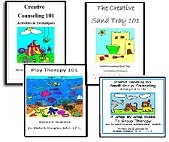
Get your complete set of the Creative Counseling 101.com eBooks by Dr. Michelle Stangline for only $98.95, that's less than $25.00 per eBook (Regular Price is $39.95 for each eBook.).
Your complete set includes:
- Creative Counseling 101
- Creative Group Counseling 101
- Creative Play Therapy 101
- Creative Sand Tray 101
For more information click the link below:
See Complete Set of eBooks For Sale Here:
New!!! "Beyond Art Therapy" 101 eBook
Over 300 pages of Beyond Art Therapy activities and techniques. Learn what I teach graduate counseling students!
See the link below for more information.
Only $39.95
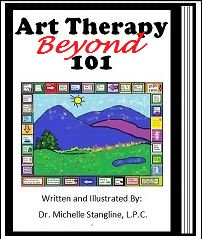
See More Invividual eBooks For Sale:
Sand Tray Therapy 101 eBook:
Learn how to do Sand Tray Therapy or enhance your skills.
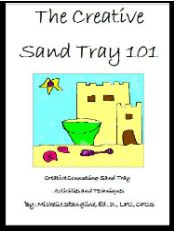
Play Therapy 101 eBook
Learn how to do play therapy or enhance your skills.
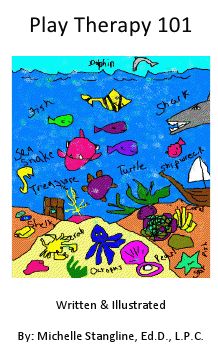
Small Group Counseling eBook For Sale:
Learn how to do creative group therapy and enhance your skills.
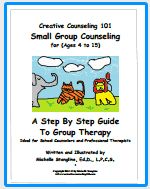
School Counselor Guidance Lesson & Social Stories eBook for sale:
Get a year's worth of school counselor guidance lessons with "Creative Warm & Fuzzy Classroom Guidance Lessons eBook". Introduce your students to the "Warm & Fuzzy Way". Click the link below for more information:
Warm & Fuzzy School Counselor Guidance Lessons eBook
